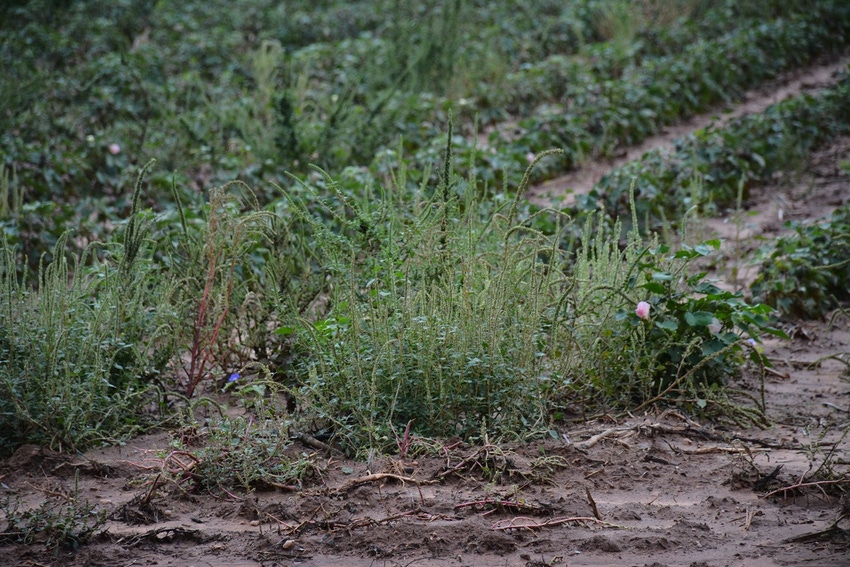February 15, 2017

South Texas, or coastal Texas, is a unique region of the greater Southwest, marked by a sub-tropical climate, unique soils and a host of both advantages and disadvantages when it comes to agriculture.
The warmer climate allows for an extended growing season, and its relationship with the tropical Gulf of Mexico offers some clear advantages, like seasonal rains, but also unique challenges, not the least of which is an environment conducive to the rapid growth and propagation of noxious and damaging weed varieties.
In the Texas Coastal Bend, for example, are growing concerns over the rampant development of glyphosate-resistant weeds, specially pigweed and waterhemp. While not unique to the Texas coast, these noxious threats thrive in the coastal environment and are gaining ground on farmers who often feel they are losing their fields to weeds.
Jason P. Ott, CEA–Ag/NR for the Texas A&M AgriLife Extension Service in Nueces County, warns that "newer is not always better," and says South Texas producers need to adopt the practice of rotating herbicides with various modes of action as part of their weed management plans, including older herbicides.
"A key component of successful crop production is effective weed management," Ott said, adding that when it comes to weed control and managing herbicide resistance, "if you like your herbicide program, you better change your herbicide program."
RESISTANT WEEDS TROUBLING
According to Ott, there are currently about 246 species of herbicide resistant weeds worldwide. But in the Coastal Bend and across many parts of South Texas, glyphosate-resistant weed varieties, especially pigweed, are the most troubling. He says waterhemp and pigweed can propagate rapidly, in excess of a half million seeds that can broadcast quickly in moderate to high winds.
Pigweed and waterhemp can be found all across the region, and they threaten the commercial production of all crops grown here, including cotton, grain sorghum and corn. While these noxious weeds are widely prolific across a number or areas across Texas and other southern states, the climate of the Coastal Bend is subtropical in the sense that seasons are poorly differentiated and the winters are short and generally mild.
In terms of moisture and dryness as well as heat and cold, the climate of the region is considered dry- to humid, compared with further south to the Mexico border where the climate is considered semiarid. The unique climate conditions experienced across the Coastal Bend make it perfectly suited for the propagation of pigweed and waterhemp, as well as being well suited for commercial crops grown across the region.
The consensus among crop specialists is that a year-round weed management program is the best way to fight development of weeds across the region, weeds that have proven they are capable of exploding rapidly once they become established in a field. To accomplish this, a plan that involves post-emergence herbicides followed by diligent scouting and additional applications of herbicides with varying modes is best suited to address weed problems.
MULTIPLE TOOLS
Ott says recent research indicates modern weed management programs should involve taking a look at herbicides that were once used extensively before the rise of glyphosate-based treatments. He says while newer modes of action should remain in your weed management plan, older herbicides with different modes are also necessary for best weed kills.
He points to a controlled greenhouse experiment where researchers were able to observe herbicide resistance in pigweed to dicamba after only three generations of plants being exposed to sub-lethal doses of dicamba. Ott says the experiment emphasizes the importance of several weed resistance prevention principles, including the need to always use the recommended rate of the herbicide being used, the timing of the application, and the spray volume to affect sufficient coverage and minimize drift. And most important is to avoid using a single mode of action in your herbicide program, scout for herbicide failures following spraying, and control any escapes before the weeds go to seed.
While the greenhouse experiment was designed to show how quickly poor herbicide stewardship practices could develop herbicide resistance in a weed population, in a field setting, following the three principles above will prevent the rapid development of herbicide resistance. He says cultivation and crop rotation will further strengthen the producer’s arsenal against herbicide resistance.
"Since the introduction of glyphosate tolerant crops over 20 years ago, it has become the backbone of many growers’ herbicide program, and we have seen how this reliance on a single mode of action has created a problem for growers in many areas of Texas," Ott warned.
NEW PRODUCTS FOR 2017
The good news, says Ott is that this year growers will also have new herbicide tolerant traits to choose from, specifically Roundup Xtend and Enlist technology. These products are triple stacked herbicide technologies in cotton he says and provide tolerance to glyphosate, glufosinate and dicamba in the case of XtendFlex Technology and glyphosate, glufosinate and 2,4-D in the case of Enlist technology.
He does warn, however, that XtendFlex cotton is not tolerant to 2, 4-D and Enlist cotton is not tolerant to dicamba.
"These new herbicide traits will allow for the application of several new herbicide formulations and herbicides with different modes of action during the growing season," Ott says.
He refers area growers to what he calls "an excellent guide" to weed management that is available online at http://bit.ly/1MN6E59.
"While growers can do several things to help mitigate the development of herbicide resistant weeds, the most effective step is to include a pre-emergent residual herbicide into their weed control arsenal," Ott adds.
A complete list of herbicide suggestions for cotton producers can found at http://bit.ly/2ki7kWE, and includes preemergence herbicide options.
You May Also Like




